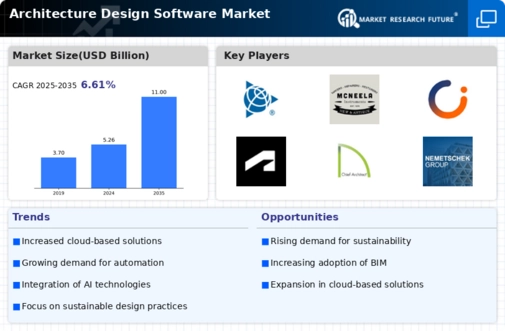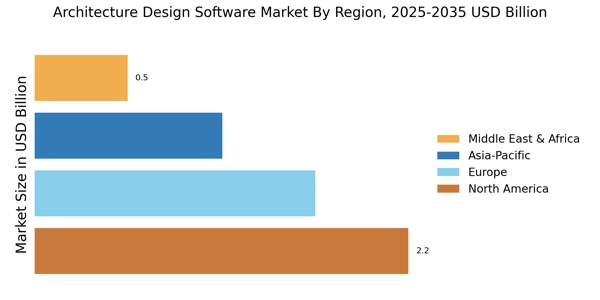The Architecture Design Software Market is currently characterized by a dynamic competitive landscape, driven by rapid technological advancements and an increasing demand for innovative design solutions. Key players such as Autodesk (US), Bentley Systems (US), and Dassault Systèmes (FR) are strategically positioning themselves through a combination of digital transformation initiatives and strategic partnerships. Autodesk (US), for instance, has been focusing on enhancing its cloud-based offerings, which allows for greater collaboration among architects and engineers, thereby shaping a more integrated design process. Meanwhile, Bentley Systems (US) emphasizes infrastructure design and management, leveraging its expertise in digital twins to provide comprehensive solutions that cater to the evolving needs of the construction industry. These strategies collectively contribute to a competitive environment that is increasingly centered around innovation and technological integration.
In terms of business tactics, companies are increasingly localizing their operations and optimizing supply chains to enhance efficiency and responsiveness to market demands. The Architecture Design Software Market appears to be moderately fragmented, with several key players exerting significant influence. This fragmentation allows for a diverse range of solutions, catering to various segments of the market, while also fostering competition that drives continuous improvement and innovation among the leading firms.
In August 2025, Autodesk (US) announced the launch of its new generative design tool, which utilizes artificial intelligence to optimize architectural designs based on specific parameters set by users. This strategic move not only enhances the design capabilities of architects but also positions Autodesk as a leader in the integration of AI within architectural software, potentially reshaping how designs are conceptualized and executed. The introduction of such advanced tools may significantly influence user adoption and retention in a competitive market.
In September 2025, Bentley Systems (US) expanded its partnership with Microsoft (US) to enhance its cloud services, focusing on the integration of Azure-based solutions for infrastructure projects. This collaboration is strategically important as it allows Bentley to leverage Microsoft's robust cloud infrastructure, thereby improving the scalability and performance of its software solutions. Such partnerships are indicative of a broader trend where companies are seeking to enhance their technological capabilities through strategic alliances, which could lead to more comprehensive and efficient design solutions.
In July 2025, Dassault Systèmes (FR) unveiled a new sustainability initiative aimed at reducing the carbon footprint of architectural designs through its 3DEXPERIENCE platform. This initiative reflects a growing trend towards sustainability in architecture, as firms increasingly recognize the importance of environmentally responsible design practices. By prioritizing sustainability, Dassault Systèmes not only addresses regulatory pressures but also aligns itself with the evolving preferences of clients who are increasingly focused on green building practices.
As of October 2025, the competitive trends within the Architecture Design Software Market are heavily influenced by digitalization, sustainability, and the integration of artificial intelligence. Strategic alliances are becoming a cornerstone of competitive differentiation, enabling companies to enhance their technological capabilities and expand their market reach. The shift from price-based competition to a focus on innovation, technology, and supply chain reliability is evident, suggesting that future competitive dynamics will increasingly hinge on the ability to deliver cutting-edge solutions that meet the complex demands of modern architecture.


















Leave a Comment